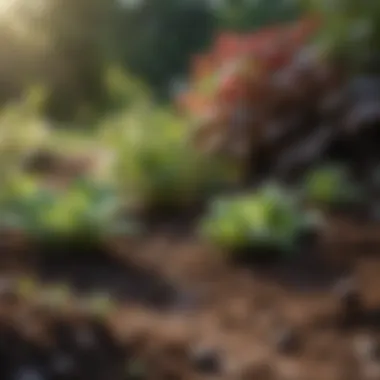Cultivating Perennials: Thriving in Direct Sunlight


Intro
Cultivating perennial plants in direct sunlight is an art that can transform any garden space. Perennials, unlike annuals, return season after season, providing consistent beauty and functionality. This guide aims to provide a thorough understanding of how to maximize growth and health for these remarkable plants in their sunlit environments.
Choosing the right perennials involves understanding their specific needs, particularly in terms of sunlight, soil, and maintenance. Sun-loving varieties bloom vibrantly and thrive under full sun exposure. This article will cover essential growth requirements, suitable perennial types, and management strategies that ensure your garden flourishes even in harsh sunlight.
Understanding Perennials
Perennials are plants that live for more than two years. Their life cycle is distinct—they grow, bloom, and die back to the ground each year, only to return again in the spring. This cycle allows gardeners to enjoy a rich tapestry of blooms throughout different seasons.
Defining Characteristics
Some common characteristics of perennials include:
- Root structures: They often have deep root systems, which help them access moisture and nutrients during dry seasons.
- Growth habits: Many perennials develop bushy forms or spread through rhizomes, creating lush landscapes.
- Longevity: With proper care, perennials can last for many years, providing a sustainable choice for gardens.
Sun Exposure Needs
Most perennials thrive in full sun, requiring at least six hours of direct sunlight daily. However, some varieties can tolerate partial shade. Understanding solar patterns in your garden can aid in optimal planting.
Selecting Suitable Varieties
When choosing perennials for sunny locations, consider the following popular options:
- Echinacea (Coneflower): Attracts pollinators and is drought-tolerant.
- Lavandula (Lavender): Known for its aromatic foliage and drought resistance.
- Rudbeckia (Black-eyed Susan): A hardy bloomer with vibrant yellow flowers.
- Sedum (Stonecrop): Succulent-type perennial that thrives in poor soils.
Selecting the right variety is not just about aesthetics; they must also align with your climate zone to ensure successful growth.
Soil Conditions
Soil composition greatly affects perennial growth. A well-draining soil is crucial as it prevents root rot and promotes healthy root systems. Testing your soil pH can provide valuable insight, as most perennials prefer a pH level between 6.0 and 7.0. Amending soil with organic matter helps enhance its structure and fertility, leading to robust plant growth.
Tips for Soil Health
- Incorporate compost to improve nutrient content.
- Mulch around plants to retain moisture and suppress weeds.
- Avoid compacting the soil when planting to maintain proper aeration.
Watering Practices
Betting on consistent watering is key, especially during the establishment phase. While perennials are hardy, they still require adequate moisture to thrive.
Recommended Watering Strategies
- Water deeply and less frequently to encourage deep root growth.
- Use drip irrigation systems to provide consistent moisture without waterlogging.
- Be mindful of drought conditions, adjusting your watering schedule accordingly.
Pest Management Strategies
Although perennials are generally resilient, they can still fall prey to pests. Regular observation and preventative measures are advisable.
- Regular Inspection: Check for signs of pests regularly; early detection can save plants.
- Companion Planting: Some plants naturally repel pests.
- Natural Predators: Encouraging birds and beneficial insects can help manage pest populations.
Understanding Perennials
To cultivate perennials successfully, it is vital to first grasp what these plants are. Perennials are plants that live for more than two years. They can return year after year, making them a favored choice among gardeners. Understanding the distinctive characteristics and classifications of perennials aids in making informed decisions when planning a garden. By knowing the requirements and features of specific perennial varieties, one can optimize growth in areas exposed to direct sunlight.
Definition and Classification
Perennials are broadly classified based on several factors, including their structure and growth patterns. Generally, these plants are divided into herbaceous perennials and woody perennials. Herbaceous perennials die back to the ground during winter but regrow when temperatures rise. Examples include Echinacea and Daylily. On the other hand, woody perennials, like shrubs and trees, remain above ground throughout the year, providing structure in the garden.


Understanding this classification helps gardeners select appropriate species based on climate, soil conditions, and personal preferences. This knowledge is critical, especially when planning to plant perennials in direct sunlight, where specific varieties may thrive better than others.
Lifespan and Growth Cycle
The lifespan of perennials can vary greatly, typically ranging from a few years to several decades, depending on the species and growing conditions. During their lifecycle, perennials exhibit specific growth stages: establishment, maturation, and dormancy.
- Establishment: This initial phase can last for one to two years during which the plant develops roots and foliage. Adequate water and soil nutrients are crucial at this stage to encourage healthy growth.
- Maturation: Once established, perennials enter their growth phase, producing flowers and foliage each season. This phase can last for many years, adding beauty to the garden.
- Dormancy: Many perennials enter a state of dormancy during winter. This is a natural process that allows them to conserve energy and maintain survival until the next growing season.
Understanding the growth cycle and lifespan of perennials not only enhances cultivation practices but also allows gardeners to manage expectations regarding their garden's aesthetic over time.
Growth Requirements of Perennials
Understanding the growth requirements of perennials is essential for successful cultivation, especially in environments exposed to direct sunlight. This section outlines the critical factors, such as sunlight, soil conditions, and appropriate watering practices that ensure robust growth. Growing perennials with the right requirements leads to vibrant gardens that not only display beauty but also thrive over time.
Sunlight Needs
Perennials, by nature, have specific sunlight needs that influence their growth and flowering capacity. Most sun-loving perennials require at least six hours of direct sunlight daily. Insufficient light can lead to stunted growth, reduced flowering, and increased susceptibility to diseases. When choosing perennial plants, it is helpful to consider the orientation of your garden area. South-facing locations usually receive the most sunlight, making them ideal for planting sun-loving varieties.
Plants that thrive in full sun often develop deeper root systems, which contribute to their resilience during dry periods. This characteristic allows them to access moisture from deeper soil layers. Therefore, a solid understanding of the sunlight needs of perennials provides insights for creating an enduring garden.
Soil Conditions
pH Levels
The pH levels of soil significantly influence the growth of perennials. The ideal pH range for most perennials lies between 6.0 and 7.5. This range promotes optimal nutrient availability, which is vital for healthy growth. A soil test can determine the pH level, guiding necessary amendments. Implementing lime can raise pH, while sulfur can lower it, creating suitable conditions for various perennial species.
A neutral to slightly acidic pH level usually ensures that essential elements are soluble and accessible to plant roots. Maintaining the right pH is a straightforward way to support plant health.
Nutrient Content
Nutrient content is another essential factor impacting perennial health. Perennials benefit from a balanced supply of nitrogen, phosphorus, and potassium, along with trace minerals. These nutrients facilitate processes such as photosynthesis and root development. Regular soil testing can help to identify nutrient deficiencies and guide the application of fertilizers.
Organic amendments, such as compost or well-rotted manure, can significantly enhance the soil's nutrient profile. This not only supports perennials' nutritional needs but also improves overall soil structure and microbiological activity, which are critical for sustained growth.
Soil Texture
Soil texture directly influences water retention and drainage, both key to perennial health. Soils can range from sandy to clay-like, with each type affecting plant growth differently. Perennials generally prefer loamy soil, which provides a balance between drainage and moisture retention. Understanding soil texture allows for better cultivation techniques, such as adjusting irrigation practices or selecting compatible plant varieties.
Well-drained soils prevent waterlogging, which can lead to root rot, while soils that are too sandy may dry out quickly, stressing the plants. By analyzing and adjusting soil texture, gardeners can create optimal growing conditions for their perennials.
Watering Practices
Frequency
The frequency of watering is crucial for ensuring the health of perennials. Newly planted perennials often require regular watering until established, while mature plants can tolerate longer intervals between watering. Overwatering can cause root diseases, while insufficient water can lead to wilting and poor growth. Observing soil moisture can inform watering needs, allowing for adjustments based on current weather conditions and soil type.
Methods
Different watering methods can be employed to optimize water use. Drip irrigation systems are highly effective for perennials, as they deliver water directly to the roots, minimizing evaporation. Hand watering can also be done, ensuring water soaks into the soil rather than running off. Each method has its advantages, and it can be beneficial to combine them based on the gardening context.
Seasonal Variations
Understanding seasonal variations in water needs is vital. During hotter months, perennials may require more frequent watering due to increased evaporation rates. In contrast, cooler months might necessitate less frequent irrigation. Tailoring the watering practices to the season greatly benefits the overall health of the perennials and helps to conserve water, particularly in sunny regions.
Ultimately, grasping the growth requirements of perennials ensures that gardeners can foster healthier plants that flourish in direct sunlight.
Best Perennial Varieties for Full Sun


Selecting perennials that thrive in direct sunlight is crucial for cultivating a vibrant garden. These varieties not only withstand intense light but often flourish under such conditions, bringing beauty and life to outdoor spaces. When choosing the right perennials for full sun, consider their flowering patterns, foliage quality, and adaptability. This understanding has significant implications for garden aesthetics and ecological balance, allowing plants to support diverse wildlife.
Top Flowering Perennials
When discussing the best flowering perennials for full sun, multiple candidates stand out. Among the most favored are Echinacea purpurea and Rudbeckia hirta. Both of these flowers exhibit resilience to drought, making them ideal in hotter climates.
- Echinacea purpurea (Coneflower) is famed for its striking purple blooms. It not only attracts pollinators like bees and butterflies but also adapts well to various soil types.
- Rudbeckia hirta (Black-eyed Susan) offers vibrant yellow petals with a dark center. Its sturdy nature allows it to thrive even in poor soil.
These varieties not only provide stunning aesthetics but also play a vital role in attracting beneficial insects, thereby enhancing biodiversity in the garden.
Foliage-focused Perennials
In addition to flowering perennials, foliage-focused varieties can significantly enrich a full sun garden. Perennials such as Salvia and Lavandula angustifolia are noteworthy.
- Salvia offers a range of colors and its aromatic leaves deter some pests.
- Lavandula angustifolia, commonly known as English Lavender, boasts silvery foliage and produces lovely flowers that attract pollinators. This plant requires minimal water and can withstand hot, dry conditions.
By incorporating foliage-centric perennials, gardeners can achieve a dynamic visual appeal, contrasting textures and colors while providing habitats for beneficial wildlife.
Herbaceous vs.
Woody Perennials
Understanding the distinction between herbaceous and woody perennials is essential in choosing the best suited for sunlight exposure.
- Herbaceous perennials like Aster and Daylily die back to the ground each winter. These plants tend to be more adaptable and often recover quickly after disturbances.
- Woody perennials, such as Rosemary and Hydrangea, exist year-round, maintaining their structure and adding depth to the landscape. They can often offer more resilience but may require more initial care to establish.
Both types can effectively contribute to a sunlit garden, but the choice depends on desired maintenance level and aesthetic preference.
Well-selected perennials not only beautify a garden but also create conducive environments for various forms of life. The right choice in perennials can greatly influence both sustainability and ecosystem health.
Pest and Disease Management
Effective pest and disease management is critical in the cultivation of perennials grown in direct sunlight. The presence of these plants often invites various pests due to their abundance and attractiveness. A comprehensive pest and disease strategy not only shields your plants from harm but also contributes to their overall growth and vitality. This section explores common pests, preventive measures, and treatment options to achieve a thriving perennial garden.
Common Pests Affecting Perennials
Perennials can be susceptible to a range of pests that hinder their growth. Some of the most common pests include:
- Aphids: These tiny insects suck sap from leaves, leading to wilting and stunted growth.
- Spider Mites: Often found in hot, dry conditions, spider mites create fine webs and cause yellowing of the leaves.
- Slugs and Snails: These creatures target young foliage, leaving ragged holes.
- Cutworms: Larvae of night-flying moths can sever young stems at the soil level.
Keep a close eye on your plants, especially new growth, as pests generally prefer tender leaves. Early detection is key to effective control.
Preventive Measures
Prevention is often more effective than treatment. Here are some measures to help protect your perennials:
- Regular Inspection: Check plants weekly for signs of pests. Look under leaves and at the soil line.
- Cleanliness: Removing debris and weeds from around your plants limits shelter for pests.
- Companion Planting: Some plants naturally deter pests. For instance, marigolds can repel aphids.
- Encourage Beneficial Insects: Ladybugs and lacewings feed on pests like aphids. Providing habitat for these insects can increase their presence in your garden.
- Healthy Plants: Provide optimal growing conditions. Healthy plants are better able to withstand pest attacks.
Treatment Options
When prevention fails and pests are present, you must consider treatment options. Several approaches can be effective:
- Insecticidal Soaps: Use these on soft-bodied insects like aphids. They disrupt the pest's cell membranes, leading to dehydration.
- Neem Oil: A natural pesticide, neem oil impacts various pests and also helps prevent fungal diseases.
- Diatomaceous Earth: This powder is abrasive to insects with exoskeletons, such as slugs and cutworms.
Always follow the application instructions carefully to avoid harming beneficial insects.
Effective management of pests and diseases is a continuous process requiring attention and adaptability. With a solid understanding of the threats your perennials face and a strategic plan in place, you can cultivate a flourishing garden.


Seasonal Care and Maintenance
Seasonal care is vital for the success of perennial gardens, especially those situated in direct sunlight. As these plants thrive in bright conditions, their needs can change with the seasons. Proper seasonal maintenance ensures plants remain healthy, vibrant, and productive. In this section, we will explore the key components of seasonal care: spring preparations, summer care, fall cleanup, and winter protection. Each part plays a unique role in optimizing growth potential and promoting sustainability in perennial gardens.
Spring Preparations
Spring is the season when most perennial plants begin to emerge from dormancy. This is a critical time to prepare your garden for optimal growth. Clearing away any remaining debris from winter helps facilitate better air circulation and reduces the risk of pests or diseases.
- Inspect the Soil: Check soil structure and texture. Compacted soil can hinder root development.
- Fertilization: Apply a balanced fertilizer to foster strong growth. Organic options such as compost or well-rotted manure are beneficial.
- Pruning: Remove any dead or damaged stems to encourage new growth and maintain plant health.
- Mulching: A layer of organic mulch can conserve moisture and suppress weeds.
Taking these steps in spring can lead to more vigorous growth throughout the warmer months.
Summer Care
During summer, perennials in direct sunlight require consistent care. Heat can stress plants, so maintaining their health is essential.
- Watering: Ensure deep watering at least once a week. Early morning is the best time for watering, as it allows moisture to be absorbed without evaporation.
- Deadheading: Remove spent flowers to encourage further blooming and extend the flowering season.
- Weeding: Regularly check for weeds that compete for nutrients and water. Hand-pulling is often effective and prevents disruption to the soil.
By implementing thorough care during summer, perennials can thrive and remain visually appealing.
Fall Cleanup
As fall approaches, preparation for winter begins. This is the time to tidy up and ensure plants are ready for the colder months ahead.
- Cutting Back: Cut back dead foliage but remember to leave some perennials intact, as they can provide winter interest and wildlife habitat.
- Soil Amendments: Adding organic matter in fall promotes healthier soil for the next growth cycle. Consider incorporating fall leaves into the soil.
- Pest Management: Inspect plants for any lingering pests or diseases and treat them before winter sets in to prevent re-emergence in spring.
Fall cleanup is not only beneficial for the current plants but also sets the stage for a successful growing season in the following year.
Winter Protection
Winter can be harsh, and perennial plants need protection to survive cold temperatures, especially those in exposed areas.
- Mulch Layer: Apply a thick layer of mulch around the base of the plants to insulate roots and help retain soil moisture.
- Wrapping: For tender perennials, wrapping with burlap can protect against harsh winds and frost damage.
- Watering: Give a final watering before the ground freezes. Dry plants are more susceptible to winter damage.
Ensuring that perennials are carefully protected during winter lays the groundwork for vibrant growth in the spring.
Maintaining seasonal care requires attention and effort, but the benefits of a thriving perennial garden in direct sunlight are invaluable.
Ecological Benefits of Perennials in Sunlight
Growing perennials in sunlight offers various ecological benefits that contribute to overall environmental health. Their role in a garden extends beyond aesthetics, influencing biodiversity, soil vitality, and efficient water use. This section explores these important benefits, emphasizing why cultivating perennials is essential not only for gardeners but also for broader ecological stewardship.
Biodiversity Enhancement
Perennials play a vital role in enhancing biodiversity. When they are planted in direct sunlight, they provide habitats and food sources for a wide array of organisms. This includes not only insects, such as pollinators like bees and butterflies, but also birds and small mammals that depend on these plants for survival.
- Attracts Pollinators: Certain varieties of perennials, particularly flowering types, are favored by pollinators. Their blooming times can help ensure that these crucial insects have a steady food supply throughout the growing season.
- Supports Wildlife: The presence of perennials creates a thriving ecosystem where various species can coexist. This stability is essential as it allows for natural pest control, as predators will find ample food in the ecosystem.
- Species Diversity: By diversifying the plant species in gardens, perennials contribute to resilience against diseases and pests, minimizing the likelihood of complete crop failure.
Soil Health Improvement
Maintaining healthy soil is critical for sustainable gardening and agriculture. Perennials aid in enhancing soil health in several ways.
- Root Systems: The deep root systems of perennials improve soil structure, reducing compaction and allowing for better drainage. This also helps in preventing soil erosion, keeping nutrients in place.
- Nutrient Cycling: As they grow, perennials contribute organic matter through fallen leaves and decaying roots. This organic material enriches the soil, improving its nutrient-holding capacity.
- Microbial Activity: The different root exudates from perennial plants promote microbial activity in the soil. A diverse range of microbes can enhance soil fertility and assist in breaking down organic matter.
Water Conservation
In areas exposed to direct sunlight, water conservation is often a concern for gardeners. Perennials have adapted to utilize water more efficiently, providing several advantages.
- Drought Resistance: Many perennial species are drought-tolerant. Their established root systems can reach deeper moisture, meaning they require less frequent watering than annual plants.
- Soil Retention: The growth of perennial plants increases soil cover, which helps reduce evaporation rates. This is particularly useful in hot climates where water loss can be significant.
- Decreased Runoff: Perennials mitigate water runoff by promoting infiltration. Their root systems create pathways in the soil, allowing rainwater to penetrate and recharge groundwater levels.
The integration of perennials in sunny environments not only enriches gardens but contributes positively to our ecological landscapes.
Overall, the benefits of cultivating perennials in sunlight are numerous. From fostering biodiversity to improving soil health and conserving water, these plants hold significance as ecological allies. By making informed choices in planting, gardeners can create sustainable environments that support both wildlife and the larger ecosystem.







